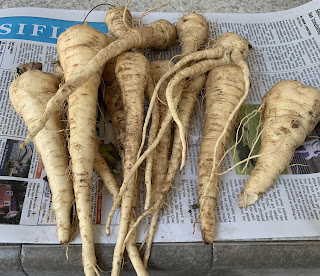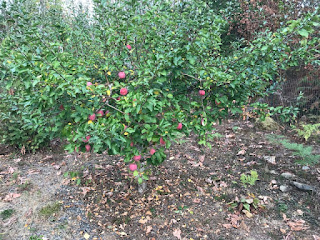 |
| Miss Broody enjoying the outdoors |
Our one hen’s egg laying spree, that is. Miss Broody’s egg production this fall had been impressive: 19 eggs in 27 days! But as it turned out, the spree was very temporary.
This fall, our area experienced weeks of very poor air quality, due to wildfires east of us. The day the really bad smoke rolled in, she didn’t come out of the coop.
Sure enough, when I went to check on her late in the afternoon, she was back on the nest.
Laying hens, you understand, generally lay early in the day. They'll rest for a few minutes on the nest, then go back outside. So our girl was definitely not sitting on her nest to actually get something done…i.e., lay an egg.
Missy had returned to being Miss Broody again.
The smoke might have had something to do with it—maybe she
was laying low to escape the worst of it. Just like the other birds and bees
and bunnies around our place had been doing for days, staying in their hidey-holes.
Still, broody was broody.
In a previous Little Farm blog post, I mentioned my dilemma
about Miss Broody’s future: a feeling growing stronger by the day, that it
wasn’t right to try and keep her.
Chickens, like other farm critters, are herd animals. I wondered if Miss Broody’s enforced solitude
was also making her more broody than she would have been otherwise—no other
hens to hang out with.
And her being alone day after day, month after month—especially
if she wasn’t eating properly—would almost certainly make her simply pine away. The
coming rain and cold would only make her solitary existence even more
miserable.
Unless, despite all our precautions, a bobcat got her first.
After the other three big cat attacks on our flock, Miss Broody was constantly on high alert. And as the weeks passed, I think her anxiety had become entrenched in her muscle memory. Even many months after the previous attack that killed our hen Little Britches, poor Broody still could hardly eat or drink.
Even when she was safe in her caged run, with me
right there with her, she would continually cast nervous glances around.
I wondered if the bobcat was yet another reason she went
broody so frequently—it's a hen’s instinct to be happily outdoors, scratching
around and dust-bathing But for Miss Broody, being outside the coop was likely too
nerve-wracking.
And I had this sinking feeling that eventually, the bobcat
would kill her somehow: either attack outright—or scare her to death.
I didn’t want to lose her—I’d grown quite fond of Miss
Broody, especially after all she’d been through. And I’ve long felt that a
little flock of hens are the heart of your homestead.
Still, more than ever, I was convinced that this scrappy
little hen needed a much safer, and companion-filled place to live. But where
could I possibly find a good home for a hen that wasn’t even laying?
Winterizing Our Little Hen Operation
Now that the weather was turning colder, I was growing
increasingly anxious about Miss Broody making it through the winter.
Before last December’s extreme winter storm, when we had five healthy, active hens, John and I had
invested in some new chicken equipment--improvements, I was sure, that would
take our chicken-keeping to the next level.
Water availability for the girls in the cold was always a
problem—their waterer would freeze solid. We’d bring a bucket of warm water
from the house out every day, but that would freeze within hours too, even when
we put the bucket in the coop.
So our first priority was keeping the girls hydrated. Off
John went to the farmer’s supply store fifteen miles away. He sprung for an
electric chicken waterer—it would keep the hens’ water thawed through the
snappiest cold snap. While he was at it, he bought a new feeder too.
The design of this new one, made of light plastic, would twirl more freely as the hens fed, thus more evenly distribute. Our old metal feeder worked by simple gravity, and invariably the feed would get hung up in the center instead of swishing into the feeding tray.
Add more damp and cold,
with the finer bits in a metal feeder would be more prone to freeze solid, the
feed would likely get hung up even more where the hens couldn’t reach it.
So armed with the new feeder, John and I thought: Old Man Winter, bring it on! We were set.
Well, guess what. The waterer failed during the first
northeaster. We tried a different extension cord, and John fiddled with the
wiring to the best of his ability, but nothing doing.
We’d wasted our money: ending up with just a very expensive
plain plastic bowl.
And the new feeder?
It twirled so efficiently that the screw mechanism holding
it together would unscrew, then the whole gizmo would fall on the ground, scattering the feed. Then
you’d have to sift through the grungy dirt in the run to find the various
parts.
John put the feeder back together numerous times, tried a
new screw, and a new washer, but nope. Finally, he threw up his hands in
frustration and we went back to using the old metal feeder.
In a very vague kind of way, I wondered if our failed improvements were trying to tell us something...
I originally posted "Miss Broody's Fate" in the December 2022 issue of my new Little Farm Writer Substack. If you’re interested in more stories from the Little Farm, you’ll find them in my Substack newsletter—you don’t have to subscribe to read it!
In any event, watch this blog or my Substack for more about Miss Broody in the future!
Photo by John F. Browne























